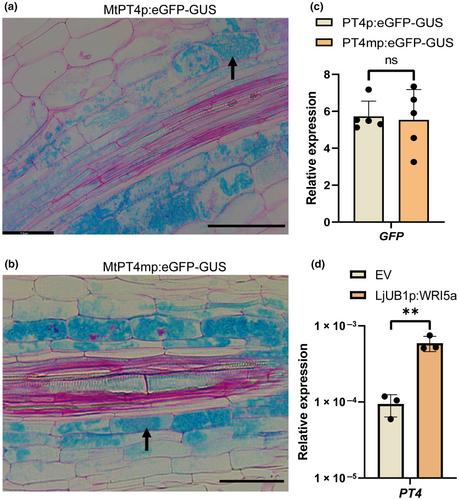The phosphate starvation response regulator PHR2 antagonizes arbuscule maintenance in Medicago
IF 8.1
1区 生物学
Q1 PLANT SCIENCES
引用次数: 0
Abstract

磷酸盐饥饿反应调节因子 PHR2 可拮抗美蒂莎草的轴丝维持。
磷酸盐饥饿反应(PHR)转录因子通过与磷酸盐饥饿反应基因启动子中的 P1BS 顺式元件结合,在调节植物磷酸盐吸收方面发挥着重要作用。最近的研究还表明,PHRs 还能通过控制许多共生基因的表达,对水稻和荷花的丛生菌根定殖起到积极的调节作用。然而,它们在假根发育中的作用仍不清楚。在Medicago中,我们曾发现假根降解是由两个SPX蛋白控制的,这两个蛋白在含有假根的细胞中高度表达。由于 SPX 蛋白与 PHRs 结合并以磷酸依赖的方式抑制其活性,我们研究了轴丝的维持是否也受 PHR 的调控。在这里,我们发现 PHR2 是 Medicago 磷酸盐饥饿反应的主要调节因子。敲除phr2后,磷酸饥饿反应、共生基因表达和真菌定殖水平均有所降低。然而,形成的轴丝降解较少,这表明 PHR2 在轴丝维持中起着负面作用。过量表达 PHR2 会导致假轴的降解增强,这一观察结果也证实了这一点。尽管许多假茎诱导基因的启动子中含有 P1BS 元件,但我们发现共生磷酸盐转运体 PT4 启动子中的 P1BS 顺式元件并不是含假茎细胞表达所必需的。由于PHR2和SPX1/3都会对轴丝的维持产生负面影响,我们的研究结果表明,它们部分是通过不同的机制来控制轴丝的维持。虽然PHR2能促进共生基因的表达和定殖,但其在含轴丝细胞中的活性需要严格控制,以维持Medicago的成功共生。
本文章由计算机程序翻译,如有差异,请以英文原文为准。
求助全文
约1分钟内获得全文
求助全文
来源期刊

New Phytologist
生物-植物科学
自引率
5.30%
发文量
728
期刊介绍:
New Phytologist is an international electronic journal published 24 times a year. It is owned by the New Phytologist Foundation, a non-profit-making charitable organization dedicated to promoting plant science. The journal publishes excellent, novel, rigorous, and timely research and scholarship in plant science and its applications. The articles cover topics in five sections: Physiology & Development, Environment, Interaction, Evolution, and Transformative Plant Biotechnology. These sections encompass intracellular processes, global environmental change, and encourage cross-disciplinary approaches. The journal recognizes the use of techniques from molecular and cell biology, functional genomics, modeling, and system-based approaches in plant science. Abstracting and Indexing Information for New Phytologist includes Academic Search, AgBiotech News & Information, Agroforestry Abstracts, Biochemistry & Biophysics Citation Index, Botanical Pesticides, CAB Abstracts®, Environment Index, Global Health, and Plant Breeding Abstracts, and others.
 求助内容:
求助内容: 应助结果提醒方式:
应助结果提醒方式:


